How Violent TV Exposure Impacts Child Development
Television is a powerful medium that shapes how children view the world. While TV can provide educational and entertainment benefits, parents, educators, and health professionals have grown increasingly concerned about TV violence in modern society.
By exploring the connection between media violence and child development, families can make more informed decisions about television viewing habits.

Impact of Violence on Children
Before diving into TV violence and childhood development, it’s helpful to examine the bigger picture regarding various forms of violence. Whether children experience it firsthand or witness it in their surroundings, violence can have profound and lasting effects on young minds.
Children exposed to violence can develop significant mental health challenges, including depression, anxiety, and post-traumatic stress disorder (PTSD). Notably, studies have shown that even infants and young children exhibit signs of PTSD after exposure to violence, contradicting the common misperception that young children don’t remember or comprehend the experience [1].
Additionally, research suggests that children who experience violence have a higher risk of developing learning disabilities and difficulties with language acquisition and cognitive processing. Children often exhibit deficits in self-regulation and executive functioning due to these developmental challenges [2].
In addition to cognitive and academic impacts, exposure to violence is associated with internalizing behaviors, such as anxiety and depression, and externalizing behaviors, including aggression and conduct disorders. These issues can lead to social withdrawal and difficulties in forming peer relationships, further isolating these children and limiting their opportunities for social learning [2].
Clearly, regardless of the exposure method, experiencing or witnessing violence can significantly disrupt a child’s development, leading to a range of mental health issues and academic difficulties. However, recognizing these profound effects is the first step in developing effective interventions.
TV Viewing and Violence Prevalence
TV violence falls under the broader heading of screen violence, with content mediums including video games, online programming, movies, and more. Screen violence, then, is loosely defined as depictions of people or characters attempting to harm one another physically.
So just how common is TV violence, and how often are children exposed to it? On average, U.S. children aged eight to 12 spend four to six hours a day watching on-screen content, with teen consumption averaging nine hours per day [3]. Unfortunately, all of these hours of online content likely contain considerable violent content.
Data reveals that 91% of movies on TV contain violence, and everything from video games to music videos include acts of violence. In fact, data suggests that U.S. children will witness 200,000 violent acts on TV before they turn 18.
Unfortunately, children’s programming isn’t immune to violent content. Studies show that 46% of TV violence occurs in cartoons, as they average 20 to 25 violent acts per hour, which is roughly five times the rate of prime-time programming [4].
The Psychological Impact of TV Violence
Along with the aforementioned outcomes related to violence exposure in general, violent television plays a significant role in shaping the values and behaviors of U.S. children, influencing their emotions and social interactions. The impact can be profound, leading to several concerning outcomes, such as [5]:
- Desensitization: Children may become “immune” or numb to the horror of violence, reducing their emotional response to real-life aggression.
- Acceptance of Violence: Among potential outcomes, the way media influences emotions is particularly concerning for young viewers. They may begin to accept violence as a legitimate way to solve problems. They may become aggressive and experience diminished conflict resolution strategies.
- Imitation of Behavior: Many children are likely to imitate the violence they observe on television, incorporating aggressive actions into their play and interactions.
- Identification With Characters: Children often identify with certain characters, whether they are victims or perpetrators, which can shape their perceptions of morality and justice.
Exposure to violent television content can significantly alter children’s perceptions and behaviors. As children absorb violent messages, their understanding of morality and conflict resolution may become increasingly distorted, raising concerns about the long-term implications for their social interactions and mental health.
Protecting Children From TV Violence
Despite the harmful effects of on-screen violence, parents and caregivers can take an active role in protecting children. Various parenting strategies can promote proper childhood development. However, the American Academy of Child and Adolescent Psychiatry suggests that parents employ the following tactics [5]:
- Monitor Viewing Habits: Parents should watch programs with their children and discuss the content they see together. This creates opportunities to help children understand the difference between fantasy and reality, while also allowing parents to address any fears or concerns arising from violent content. Regular monitoring helps parents stay aware of what their children are watching and how they react to it.
- Set Clear Boundaries: Establish and maintain specific viewing times and program choices. Create a schedule that balances screen time with other activities, and ensure children understand which programs are acceptable and which are not.
- Use Parental Controls: Take advantage of built-in TV and streaming features like content blockers and rating systems for violent programming, which create an additional layer of protection against inappropriate content.
- Encourage Alternative Activities: Provide engaging options for entertainment beyond television, such as reading, outdoor play, and creative activities. This not only reduces exposure to violent content but also supports healthy development.
- Discuss Violence: When children watch violent content, talk with them about why violence is wrong and help them develop empathy for others. Regular discussions help children process what they see and develop critical thinking skills.
TV and Movie Ratings Guidelines
While parents and caregivers have the last word on what’s appropriate for their child’s stage of development, the following ratings can help them make informed decisions about programming.
Television rating systems include:
- TV-Y: Appropriate for all children, these programs are designed specifically for a young audience.
- TV-Y7: Crafted for children seven and older, these shows may contain mild fantasy or comedic violence that young children might not understand.
- TV-G: Most parents would find this content suitable for all ages.
- TV-PG: Programs can contain material parents might find unsuitable for younger children, including moderate violence or suggestive dialogue.
- TV-14: Shows may contain sophisticated themes, sexual content, strong language, and intense violence.
- TV-MA: Programs are designed to be viewed by adults and may be unsuitable for children under 17.
Movie rating classifications include:
- G: Content is deemed suitable for all ages.
- PG: Some material may not be suitable for children, so parental guidance is suggested.
- PG-13: Some material may be inappropriate for children under 13.
- R: Content is meant to be viewed by adults only.
- NC-17: A more restrictive rating than R, it indicates content intended only for adults, with no one 17 or under permitted to view it.
Note that some programs, such as news, sports, religious content, and home shopping programming, are exempt from ratings systems. Additionally, some screen-based content mediums have additional guidelines. For example, the Entertainment Software Rating Board provides insights on video game violence, alcohol and drug references, and more.
How to Limit Screen Time
Along with exposing children to violence, considerable screen time is also associated with obesity, trouble sleeping, and increased risks for anxiety, depression, and attention issues.
Various sources suggest that parents and caregivers limit screen time to one to two hours per day for those age two and over (with no screen time for children under two) [6].
The following strategies can help parents and caregivers decrease screen time [6]:
- Remove Screens From Children’s Bedrooms: This helps parents monitor content more effectively and prevents unsupervised viewing of potentially violent programming.
- Set Clear Boundaries: Establish and enforce rules to ban screens during meals and homework time. This creates structure around viewing habits and helps children develop healthier relationships with screens.
- Track Screen Time: Keep a record of time spent watching TV or using other screens. Try to match screen time with an equal amount of physical activity to promote better health outcomes.
- Create Screen-Free Zones: Designate certain areas or times of day as screen-free zones. This encourages children to engage in other activities such as reading, creative play, or outdoor activities.
While they may sound simplistic, these strategies can significantly reduce screen time and promote healthier habits for both children and caregivers.
This balanced approach to media consumption can help families mitigate the negative impacts of excessive screen exposure and encourage more active, engaging lifestyles.
A Balanced Approach to Well-Being
Television violence has become a seemingly unavoidable part of modern childhood, but its effects can be managed through thoughtful intervention and support. By exploring the connection between media exposure and child development, parents, educators, and healthcare providers can work together to create safer viewing environments for children.
Through consistent monitoring, open discussion about violent content, and healthy viewing boundaries, parents can help children process media content in ways that support their emotional health and psychological growth.
The goal is not to eliminate television entirely but to create a balanced approach that protects children while allowing them to benefit from quality programming. With proper guidance and support, children can develop the critical thinking skills needed to navigate an increasingly media-rich world while maintaining their emotional well-being and healthy development.
- U.S. Department of Veterans Affairs. (2025, March 26). Community violence: The effects on children and teens. U.S. Department of Veterans Affairs. https://www.ptsd.va.gov/understand/types/community_violence_child.asp. Accessed 13 May 2025.
- Perkins, S., & Graham-Bermann, S. (2012). Violence exposure and the development of school-related Functioning: Mental health, neurocognition, and learning. Aggression and Violent Behavior, 17(1), 89–98. https://doi.org/10.1016/j.avb.2011.10.001. Accessed 13 May 2025.
- American Academy of Child and Adolescent Psychiatry. (2024, May). Screen time and children. American Academy of Child and Adolescent Psychiatry. https://www.aacap.org/AACAP/Families_and_Youth/Facts_for_Families/FFF-Guide/Children-And-Watching-TV-054.aspx. Accessed 13 May 2025.
- American Academy of Family Physicians. (2022, January). Violence in the media and entertainment (position paper). American Academy of Family Physicians. https://www.aafp.org/about/policies/all/violence-media-entertainment.html. Accessed 13 May 2025.
- American Academy of Child and Adolescent Psychiatry. (2017, December). TV violence and children. American Academy of Child and Adolescent Psychiatry. https://www.aacap.org/AACAP/Families_and_Youth/Facts_for_Families/FFF-Guide/Children-And-TV-Violence-013.aspx. Accessed 13 May 2025.
- Medline Plus. (2023, April 4). Screen time and children. National Library of Medicine. https://medlineplus.gov/ency/patientinstructions/000355.htm. Accessed 13 May 2025.
The Clinical Affairs Team at MentalHealth.com is a dedicated group of medical professionals with diverse and extensive clinical experience. They actively contribute to the development of content, products, and services, and meticulously review all medical material before publication to ensure accuracy and alignment with current research and conversations in mental health. For more information, please visit the Editorial Policy.
MentalHealth.com is a health technology company guiding people towards self-understanding and connection. The platform provides reliable resources, accessible services, and nurturing communities. Its purpose is to educate, support, and empower people in their pursuit of well-being.
Linda Armstrong is an award-winning writer and editor with over 20 years of experience across print and digital media.
Holly Schiff, Psy.D., is a licensed clinical psychologist specializing in the treatment of children, young adults, and their families.
The Clinical Affairs Team at MentalHealth.com is a dedicated group of medical professionals with diverse and extensive clinical experience. They actively contribute to the development of content, products, and services, and meticulously review all medical material before publication to ensure accuracy and alignment with current research and conversations in mental health. For more information, please visit the Editorial Policy.
MentalHealth.com is a health technology company guiding people towards self-understanding and connection. The platform provides reliable resources, accessible services, and nurturing communities. Its purpose is to educate, support, and empower people in their pursuit of well-being.


